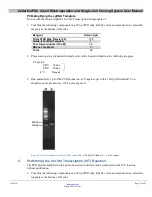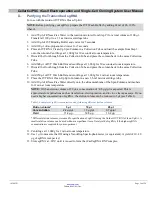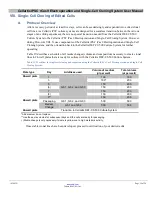
Cellartis iPSC rCas9 Electroporation and Single-Cell Cloning System User Manual
(030619)
takarabio.com
Takara Bio USA, Inc.
Page 22 of 24
C.
Culturing Single-Cell Colonies
After single-cell cloning, cells will proliferate into emerging colonies (Figure 10) that will be passaged for
further expansion during scale-up.
Figure 10. A single cell seeded in one well generates an emerging colony.
Representative images of GFP-actin iPS cells taken 24 hr
(top) or two weeks (bottom) after single-cell cloning.
Changing Media on Single-Cell Colonies in the 96-Well Plate
NOTE:
A media change in the 96-well plate is recommended on Day 5 post-seeding and then every other
day (see Table IV for guidance). If the medium turns yellow due to high metabolic activity, change the
media every day.
Preparing DEF-CS SCC Medium for Establishment of Single-Cell Colonies
1.
Prepare 150 µl per well of DEF-CS SCC medium by adding DEF-CS GF-1 (dilute 1:333), GF-2
(dilute 1:1,000), and GF-3 (dilute 1:1,000) to Cellartis DEF-CS 500 Basal Medium according to
Table IV.
2.
Prepare fresh medium on the day of intended use and warm it to 37°C ± 1°C immediately before use.
Discard any leftover warmed medium.
Changing Media
1.
Check cells under the microscope; photo document as necessary.
2.
Carefully discard 150 µl of the medium from each well and add 150 µl of newly warmed medium
into each well of the plate. It is recommended to always use manual pipetting (not a vacuum pump).
Avoid flushing medium directly onto the cell layer.
3.
Place the cell culture plate in an incubator at 37°C ± 1°C, 5% CO
2
, and >90% humidity.
NOTE:
The colonies will be ready to passage from the 96-well plate to a 48-well plate after 8–14
days, depending on the generation time of the specific iPS cell line (Figure 11).





















